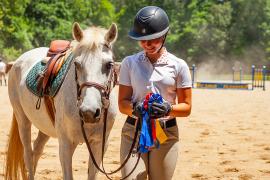When we visited camps this past summer, we saw many campers having wonderful adventures on ropes courses, climbing walls, zip lines and out in the wild. These are all forms of what we would — in our technical insurance language — call "elevation risks."
Given that many young people missed out on camp during the pandemic, it was refreshing to once again see them pushing themselves, and each other, to overcome fears, learn new skills, and stretch their understanding of what they are capable of doing.
Tight Labor Market Impacts Supervision
According to Redwoods consultant and former camp director Katie Johnson, however, the joy she felt in seeing young people scaling new heights was somewhat tempered by more than one example where safety practices were leaving too much room for error, particularly at camps that were finding themselves short staffed:
“Activities like ropes courses and climbing walls were definitely one area where the tight labor market was having an effect. On more than one occasion we saw camp leadership staffing a ropes course or belaying a climbing wall— sometimes for hours on end without a break — and they were doing so while multitasking, simultaneously managing other areas of camp programming and operations for example.”
Ensuring Undivided Attention
Katie goes on to explain that the inherently high-risk nature of these ropes courses and climbing activities means that anyone responsible for supervising them will need to remain 100 percent focused on that activity, and that activity alone. Not only does that mean avoiding multitasking, and making sure that other areas of camp are properly staffed, but it also means taking breaks, and rotating out staff so that their attention doesn’t wander:
“We would never expect a lifeguard to watch a waterfront for hours on end without taking a break. And that’s partially because there are really rigorous best practices in place as to what lifeguards should and should not be doing while they are on duty. I think it’s fair to say that while there are guidelines for camps on elevation risk, these guidelines aren’t always quite as fully defined as they are for certified lifeguards, for example.”
According to Katie, there is another aspect of waterfront/pool safety that could be adapted to managing elevation risk, and that’s the practice of regularly simulating realistic rescue scenarios not just at the beginning of the season, but throughout the summer:
“If a staff takes training for the first time in June, are they going to retain that knowledge and those skills if and when they have to perform a rescue for real 8 weeks later? A ropes course rescue off a static course is very technical. And typically to pass certification, it is timed. Most times it takes a lot of practice just to pass the initial certification course. If not practiced throughout the summer, there is no muscle memory to kick in to get the participant to the ground.”
Planning Now for a Safe Summer
Katie recommends spending time now, during the off season, to review your camp’s supervision and training protocols for ropes courses and adventure activities and, where necessary, updating them. She recommends that these protocols include:
- Who is authorized to facilitate challenge or adventure activities, and what certifications or trainings are required
- How often leadership will observe activities and check on practices, including unannounced walkthroughs; use of anchors where available; equipment checks; completing of log books etc.
- Who is authorized to participate in these activities, and what training is required (e.g. age or size limits.)
- Minimum staff-to-camper ratios, including supervision of campers who may be waiting for their turn
- The maximum time a staff member can facilitate these activities before taking a break
- Supplies needed for effective supervision — for example sunscreen, shade, water, first aid kit etc.
- A process for documented in-service trainings, team talks and refreshers throughout the camp season, including documented practice of rescues
- The protocols for closing the activity if ratios cannot be met
- Emergency Action Plan for if something goes wrong
This may seem like a daunting list, says Katie, but planning these protocols now will help ensure that these quintessential camping activities are able to continue seamlessly during the summer next year:
“Ropes courses, climbing walls, and adventure/challenge activities are a huge part of the camp experience. In fact, we as camp professionals are often so familiar with these activities that they can feel like second nature. That’s good in many ways, because we know what we are doing and we are experts in our field. But it also means that complacency can set in, or that we miss minor details where the practices on the ground don’t necessarily meet our policies each and every time someone puts on a harness. So this type of planning can go a long way toward closing the gap between protocols and practices, and it really can save a life.”
This blog was provided by The Redwoods Group.
Photo credit: Wavebreakmedia/iStock via Getty Images.
Periodically, the American Camp Association (ACA) makes timely and relevant information about products and services available to its members so they can make informed decisions for their camps. However, the ACA does not endorse products, services, or companies.
The views and opinions expressed by contributors are their own and do not necessarily reflect the views of the American Camp Association or ACA employees.



